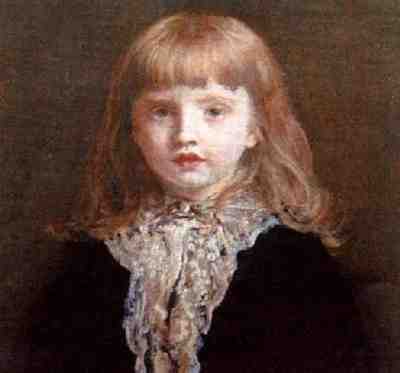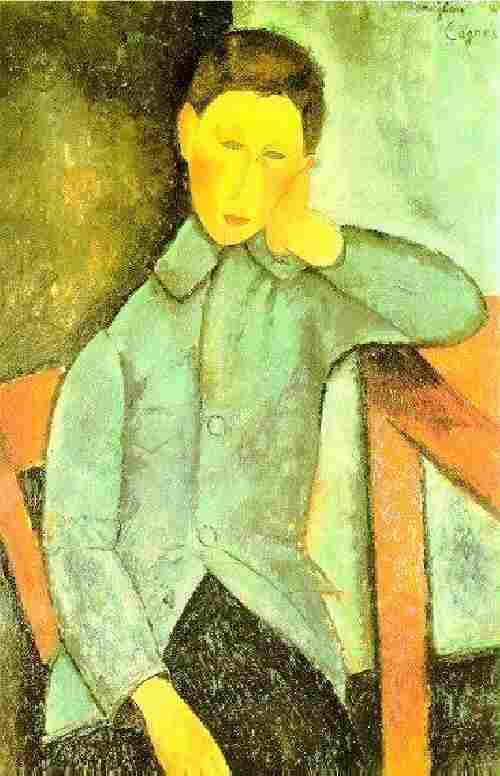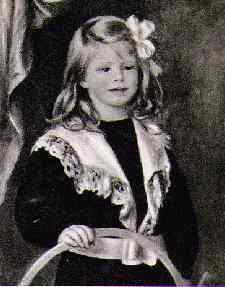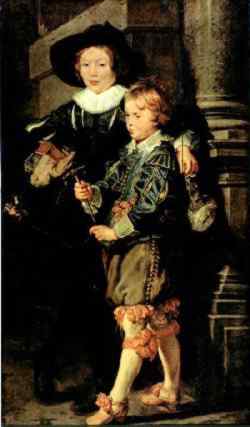
Artists (M-R) Illustrating Boys' Fashions

Figure 1.--This Millais portrait shows that many English boys were not as prone to have their hair curled as American boys and instead wore it in the French style. Note the black velvet. This was painted nearly two decades before the Little Lord Fauntleroy craze erupted in America.
|
|
Some of the most important artists providing information on boys'
fashions in different countries include:
Makovsky, Konstantin (Russia, 1839-1915): Makovsky is best known as a painter of Russian folk scenes, especially of rural peasant life. As a result he provides us some fascinating depictions of how Russian boys dressed in the 19th century. His paintings are highly detailed and very accurate. He was a founding member of the revolutionary movement known as the "Wanderers". He established himself in an early phase of his career as a champion of Russian subject matter. He had an enormous impact on the direction of art in Tsarist Russia. He advocated freedom from restrictive Academic rules and subject matter.
Manet, Edouard (France, 1832-83): Manet was a noted French painter and printmaker. In his career he made the transition from the realism to Impressionism. He establish new precedents in his choice of subjects, preferring contemporary events. He exhibited in 1863 at the Salon des Refusés, arousing the hostility of critics steeped in realism, but was aplauded by the young painters who were later to be many of the great Impressionists.
Martinelli, A. (Canada, early 20th century): We have no information on this Canadian artist. Apparently he is not very well known. We do have one of his oil paintings depicting a boy wearing knickers.
Matteson, Tompkins (United States, (1813-84): Tompkins Matteson is an interwsting painter noted for his genre paintings, providing many fascinating scenes of mid-century American life when the camera was still largely restricted to the photographic studio. He is a noted painter who worked in upstate New York during the 1850s. He is known for both his genre and historical subjects. Especially his genre pictures provide a good glimpse of ordinary American children, how they dressed and behaved.
Merritt, Anna Lea
(England, ??): Victoria Pre-Raphaelite painter. She did some charming portraits of children and families.
Meyer, Carl V. (Denmark, 1870-1938): Carl Vilhelm Meyer was educated at the
Academy of Fine Art under F. Vermehren. He represented the group of artists who pictured the common peoples life, a realistic school which is paid more and more attention to. Carl V. Meyer was also called the poor people's painter. He himself was a was the son of a
shoemaker but because of his talent he managed to get scholarships for his education as an artist. He exhibited at the main exhibitions in Copenhagen (among them at Charlottenborg) and in Munich (Germany). In 1909 he received the reward Serdin Hansens Pr. for a painting at Charlottenborg.
Meytens, Martin van (Austria, 1659-17??): This Sweedish-born painter lived ans worked in Vienna, Austria. He studied under his father, the painter Martin van Meytens the Elder. He traveled throughout Europe stydying art. He
lived and worked for a long time in Rome and Turin. At first he spealized in little enamel miniature portraits. He changed to oil painting only around 1730, having settled in Vienna. Here he became very popular as a portrait painter. He became a court painter in 1732 and in 1759 became the director of the Viennese Academy of Fine Arts. He did many masterfull portaraits of Emperess Maria Theresa, including one particularly nice work of her family.
Millais, Sir John Everett
(England, 1829-96): English portrait
and historical painter born in Southhampton. He exhibited at the Royal Acadeny when he was only 17 years old. His Pizarro Seizing the Inca of Peru is considered on of the best historical works shown. He became associated with the Pre-Raphaelites, including Dante Gabriel Rossetti and Holman Hunt. His first Pre-Raphaelite painting was a scene from the Isabela of Keats, recalled the manner of the early Flemish and Italian masters. He mairred Euphenmia Gray in 1855. He was elected an associate of the Royal Academy in 1856. Other major works include Chill October (1871), The Northwest Passage (1873), and Effie Deams (1877). His work includes several portraits of children, providing fascinating glimpses of the clothes wor by wealthy children during the second half of the 19th Century. Millais was created a baronet by Queen Victoria in 1885 and elected president of the Royal Academy in 1896. There's a new exhibition of Millais portraits in London during 1999. One critic in reviewing the exhibit bemoaned how the painter abandoned the pre-Raphaelites to paint society portraits including "sickly sweet portraits of children."

Figure 2.--This painting may be "Boy with blue waistcoat" (1919). Computers somtimes alter colors. The portrait was painted during Modigliani's time in Cagnes. He used this pose in several of his portraits.
|
|
Modigliani, Amedeo (Italy, France, 1884-1920): Amedeo Modigliani is one of those artists tht even rank anateurs can instantly identify. He was born in Italy, but began to paint the portraits for which he is now famous in the 1900s after he moved to Paris. Modigliani has his own unique style, best expressed in wonderfully mannered portraits. His portraits were not an instant success and he endured gret poverty, which contributed to his poor health. He died of tuberculosis and drink when he was only 35 yeatrs old. He left a wonderful collection of portraits, including a few boys.
Moulten. L. (United States, mid-19th century): HBC has virtually no information on this primative (naive) artist. We believe that he was American. We have one portrait done in 1853. It is of interest because it shows a boy wearing a tunic in what appears to be an early sailor style. This is one of the earliest American images that HBC has which shows that the sailor style that began in Britain had spread to America.
(Le) Nain (France, 17th century): Le Nain (the Dwarf) is the name used by three French brothers: Antoine (about 1588-1648), Louis (about 1593-1648) and Mathieu (about 1607-77). They began working in Paris during 1629. The brothers became members of the l'Académie
Royale of painting and sculpture. This was the year the Academy was founded and the tear that Antoine and Louis died. They form part
[? aux côtés de Georges de la Tour] of the group of painters of the r?alit?, strongly influenced by reality "clair-obscur" of Caravage. The brothers formed an association and signed without their first (Christian) which makes it rather difficult to attribute their works individually to one of the three brothers.
Nesterov, M.W. (Russia, 18??-??): A British reader notes the Russian artist called M.W. Nesterov. He painted a scene set in the the 19th Century showing a boy in the countryside talking to a hooded figure. It seems that the boy is dreaming and in the dream he meets the spirit of death. This spirit will take the boy away to heaven. Despite this being a sombre theme I thought the boy's clothes were interesting as he appears to be in Russian clothes. We have been able to find little information on the artist.
North, Noah (United States, early 19th century): American primitive (naive) artist Noah North painted many portraits, including families and children. Although he did not master perspective well, his detailed paintings provide a good record of early 19th century fashions before photography was developed.
Peale, Charles Wilson (United States, 1741-1827): Charles Willson Peale is one of tghe best known early American artists. He was born in Queen Anne's County, Maryland in 1741.
He came to Annapolis at the age 9 to apprentice to a local saddler. He received no actual art training and taught himself to paint by watching portraitist John Hesselius work. He observed John Singleton Copley on a visit to Boston. At this time he began to getv commissions for portraits from the the Annapolis gentry. We note a painting of the Stewart children which we believe was done by him, probably in the 1770s.
Osgood, C (United States, 18??-?? ): A Boston dealer reports that C. Osgood was a Boston painter, but HBC can find no further information about him. We have one portrait that looks to be a 19th century work, but that is only a guess at this time. Unsually the boys clothes are not painted, but the facial portrait does detail what looks to be a natuarally curly style.
Pendergast, Maurice Brazil (American-Canadian, 1858-1924): I have little informaion about Maurice Pendergast at this time. We do note a lovely image of chidren sailing their sailboats in a park.
Perov, Vasily (Russia, 1834-82): Vasily Perov was educated in the provincial Arzamass School of Art. During 1853-61 Perov
studied at the Moscow School of Painting, Sculpture, and Architecture. He lived in Paris during the early 1860s studying art. Returning to Russia, Perov became a founding member in the Circle of the Itinerants. In 1886 Vasily Perov was awarded the title of member of the Petersburg Academy of Arts. Perov is best known for his sympathetic genre scenes and portraits, including serfs and peasants.
Picasso, Pablo (Spain, 1881-1973): Pablo Picasso is one of the towering figures of the 20th century. Pablo Picasso was born in 1881. His father was an art teacher at recognized at an early age that his son was very talented. He devoted considerable effort in developing that talent. There is a small museum in Barcelona, the Museo de Picasso, that focuses on the artists early works. Picasso went through many stages and as a resulted painted in many diffeent styles. He is best known for cubis but many of his early works are stkingly realistic. From an early age he exibited a rebelious spirit. He spent much time in in th Barcelona cafes as a teenagers debating the issues of the day with friends. He went to Paris and was influenced by te impressionists and other French art movements. He was especially struck by Toulouse-Lautrec's sketchy appoach. He spent his early years moving back and forth between Frnce and Spain. We include him here because of his enormous impact n Western art. He did many portraits, but relatively few provide detailed information on clothing.
Pissarro, Camille (France, 1830-1902): Pissarro was the son of a Sephardic Jewish father and Dominican mother. He grew up in the Caribbean, but he studied and painted in France. He was one of the most productive of the impressionists. For many years he painted in obscurity and great poverty. Like Renoir he painted several studies of children. He had a four sons and one daughter, who died at an early age. Several painting of her exist. The most famous one shows her in a smock with short pants, an unusual costume of a girl. All of the boys wore long hair when they were young. The youngest boy until he was 11 or 12. Some the books on Passario contain photographs of his children. At least one of these photos shows a fairly large boy at play with the ends of his hair rolled up on curlers.
Prior, William Matthew (U.S., 1806-73): American primitive painter was born in was born in Bath, Maine in 1806. He advertised his painting skills in the Maine Inquirer in 1827 and 1828. Prior prepared his own canvases, ground his own paints, and with the help
of his sons made some of his own frames. The artist produced some landscapes, but because of public demand, he was primarily a portrait painter. Prior's work is startling in the stlistic variations. His portraits range from near academic compositions to very primative naive works. The many portraits provide a very useful view of children's clorhes in the early 19th centuty.
Raeburn, Sir Henry (Scotland, 1746-1823): Sir Henry Raeburn is one of the most highly regarded Scottish portrait painter. He was born in Stockbridge, near Edinburgh. An orphan, he was apprenticed to a goldsmith and taught himself to paint, progressing from miniatures to full-size canvases. After marrying an affluent widow in 1780 he was able to devote himself fully to portrait painting. In 1787 he returned to Edinburgh from two years in Italy and soon gained recognition as a portraitist of the Scottish upper class. His portraits of Scottish boys are notabe for the English styles in which they dressed and the absence of kilts.
Ramsay, Allan (Scotland, 1713-84): Most renowned Scottish
portrait painter. Ramsay was born in Edinburg, the son of a poet whom
he is named after, He was trained in Edinburgh, London, and Rome.
He was made the court painter to King George III in 1767, and became
one of the most successful portrait artists in England. He executed
many portraits of the King and Queen, court intimates, and other
celeberties of the day. His masterpiece is a portrait of his wife which hangs in the Scottish National Gallery, Edniburgh. Americans know Ramsay's work as many of the images of George III during the Revolutionay War were painted by Ramsay. One famous portrait of the king hangs in Independence Hall, Philadelphia.

Figure 3.--Renoir painted his son Jean in 1901 with the boy in a Fauntleroy suit. French boys often wore long hair, but their hair was not commonly done into ringlet curls like Jean's hair here.
|
|
Renoir, Pierre-Auguste (France, 1841-1919): Renoir was born at Limoges. He began his career in 1854 at a Paris porcelain factory, gaining experience with the light, fresh colors that were to distinguish his Impressionist work and also learning the importance of
craftsmanship. His predilection towards gay, light-hearted themes was
also influenced by the great Rococco masters, whose works he studied in
the Louvre. Renoir in 1862 entered the studio of Gleyre and there
formed a lasting friendship with
Monet, Sisley, and Bazille. He became a
leading member of the group of Impressionists who met at the celebrated
Café Guerbois. Renoir endured much hardship early in his career, but
he began to achieve success as a portraitist in the late 1870s and was
freed from financial worries after the dealer Paul
Durand-Ruel began buying his work regularly in 1881. These portraits
include several family portraits illustrating children's clothes.
By this time Renoir had 'travelled as
far as Impressionism could take me', and a visit to Italy in 1881-82
inspired him to seek a
greater sense of solidarity in his work. The change in attitude is seen in The Umbrellas
(NG, London), which was evidently begun before the visit to Italy and finished afterwards;
the two little girls on the right are painted with the feathery brush-strokes characteristic of his
Impressionist manner, but the figures on the left are done in a crisper and drier style, with
duller coloring. After a period of experimentation with what he called his `manière aigre'
(harsh or sour manner) in the mid 1880s, he developed a softer and more supple kind of handling. At the same time he turned from contemporary themes to more
timeless subjects, particularly nudes, but a lso pictures of young girls in unspecific settings. As his style became grander and simpler he also took up mythological subjects (The Judgement of Paris Hiroshima Museum of Art; 1913-14), and the female
type he preferred became more mature and ample. In the 1890s Renoir began to suffer from rheumatism, and from 1903 (by which time he was world-famous) he lived in the warmth of the south of France. The
rheumatism eventually crippled him (by 1912 he was confined to a wheelchair), but he continued to paint until the end of his life, and in his last years he
also took up sculpture, directing assistants (usually Richard Guino, a pupil of Maillol) to act as his hands. Renoir is perhaps the best-loved
of all the Impressionists, for his subjects---pretty children, flowers, beautiful scenes, above all lovely women---have instant appeal, and he communicated the joy he took in them with great directness. `Why
shouldn't art be pretty?', he said, `There are enough unpleasant things in the world.' He was one of the great worshippers of the female form, and he said `I never think I have finished a nude until I think I could pinch it.' He also delighted in painting his sons. Most
of those paintings were executed when the boys were younger and wearing dresses and smocks or fancy Fauntkeroy suits. They provide a good
idea of French boys clothes in the late 19th and early 20th Centuries. One of his sons, who was a particularly favorite subject was the elebrated film director Jean Renoir (1894-1979), who wrote a lively and touching biography (Renoir, My Father) in 1962.
Reynolds, Joshua (England, 1723-92): Joshua Reynolds, the son of a clergyman, was born near Plymouth in 1723. He was sent to London to study art in 1740. He was apprenticed to Thomas Hudson but William
Hogarth and Allan Ramsay had the most influence of his style. After a period in Rome (1749-52), Reynolds returned to England where he established himself as one of country's leading portrait painters. Leading figures painted by Reynolds inclu ded Josiah Wedgwood, Warren Hastings, Sir Joseph Banks and David Garrick. When the Royal Academy was established in 1768, Reynolds was elected its first president. The following year he was knighted. One of the masters of the age with whiuch he competed was Sir Thomas Gainsbourgh. Like Gainbourouh, he painted one of the famed colored boys--in Reynolds case the "Brown Boy". In 1784 Reynolds was appointed as painter to George III. However, 5 years later his sight began to deteriorate and he was forced to give up painting.
Richmond, George (England, (1808-96): George Richmond was an eminent Victorian artist, drawing many of the greats of the era, men like John Ruskin and Charles Dickens. He was a hugely prolific artist, both painting and drawing. Richmond was also a noted engraver. He amassed a trenmendous body of work, including some wonderful portraits of children.
Ripingille, E.V. (England, 1798-1859): We have been unable to find any biographical information on this English artist. He was active during the late Regency and early Victorian eras and that he at least sometimes painted on wood. We have noted a portrait by him of Reginald Henry Bean with his wife Emma (daughter of J.R. Lucas of the Nailsea
Glassworks) and family on the Backwell Hill painted in 1829. It is a wonderful example of Regency clothing.
Riverra, Diego (Mexico, 1886-1957): Diego Rivera was perhaps the greatest of Mexico's murlaist painters. He was influenced by various art movements. His simplified, colorful images help capture a taste of Mexico's pre-Colombian art. His murals focused on the Mexican earth, the farmer, the laborer, and included many popular and notorious characters. One well known image painted in 1927 was of a little Mexican farm boy which he entitled, "Retrato de Ignacio Sanchez". The painting shows Rivera's destinctive use of color and characture. It illustrates the dress of a rural Mexican farm boy until the 1960s.

Figure 4.--Rubens painted this portrait of his sons Albert and Nicholus was painted about 1625.
|
|
Rossetti, Daniel Gabriel (England, 1828-82): Dante Gabriel Rossetti is considered to be the central figure of the English Pre-Raphaelite artists. He not only started the original Brotherhood with Holman Hunt and John Everett Millais,but he was also the poetic inspiration of the movement. Daniel was born in London in London in 1828. His father had come to England in 1824 and was a professor of Italian at King's College, London. Rossetti is known for several glorious alegorical paintings. One. "The Beloved" included an American slave boy he noticed in London. It was painted while the Civil War was being fought in America.
Rubens, Peter Paul (Flanders, 1577-1640): Rubens is one of the
great masters of the Flemish school. He was born in Siegen, Westphalia.
In 1599 he was admitted a master of the Brotherhood of St. Luke in
Antwerp. He traveled to Italy in 1600 to view the work of the great
masters. He entered the service of Vicenzo Gonzaga, Duke of Mantua, as
Gentleman of the Chamber and court painter. He was dispatched on a
mission to Phillp of Spain in 1605, beginning a diplomatic career for which
his keen intelect, polished urbanity, and linguistic achievement
qualified him. While in Madrid he painted many Spanish nobels as well
as historical subjects. He settled in Antwerp and was appointed court
painter to the Archduke Albert and his wife Isabella. His masterpiece,
Discent from the Cross was completed in 1614. Marie de Medicis,
the French Queen Mother, invited Rubens to France in 1620 to assist in
the decoration of the Luxembourg Palace. He undertook 24 large works
commemorating
her mairrage to Henry IV. In the ensuing years he undertook a
series of diplomatic mission s that brought him to the English, French,
and Spanish courts. In return for these services he was knighted by
both Charles I (England) and Philip IV (Spain). His portraits are mostly of adults, but family portraits do provide some insights into the clothes worn by 17th Century children.
HBC

Navigate the Boys' Historical Clothing Web Artist pages:
[Return to the Main individual artist alphabetical page]
[Artist A-F]
[Artist G-L]
[]
[Artist S-Z]
Navigate the Boys' Historical Clothing Web Site:
[Return to the Main art page]
[Introduction]
[Activities]
[Biographies]
[Chronology]
[Clothing styles]
[Countries]
[Bibliographies]
[Contributions]
[FAQs]
[Glossaries]
[Satellite sites]
[Tools]
[Boys' Clothing Home]
Created: February 29, 1999
Last updated: November 7, 2003


